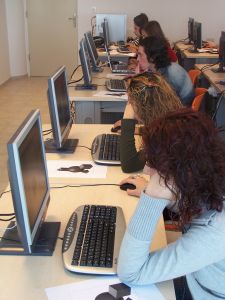 Do You Want a Job in the Game Industry?
Do You Want a Job in the Game Industry?
Game jobs aren’t easy to land, and we get pretty regular inquiries about how to do just that for game writer, game designer, and other game industry jobs. The game industry is small, insular, and fiercely competitive. There are a lot of very smart people who would give their eyeteeth for a game job. Are you one of them?
One of the first questions I ask people is, “Why do you want a game job?” Many young idealistic game-job seekers have only a fuzzy idea of what the day-to-day grind is like in the inner sanctums of the game industry.
Game Job Upsides
You’re probably familiar with the glory. It’s a huge emotional jolt to see your creative work packaged up in a glossy box, discussed in magazines, and enjoyed by thousands of people around the world. One of the games I worked on was followed slavishly by fans, blogged about, anticipated, and on release, quickly analyzed and reverse-engineered so that fans could extend the game and create their own levels. Just being able to make such work is enormously satisfying, even without the public angle. Creative people love to share their efforts. We’re no different.
Game Job Downsides
- The work itself can be gruelling. Unlike almost any other kind of software development, game designers and even game writers often find themselves facing problems that have never been solved before, using tools that are not designed for that purpose or are barely functional due to a shortage of programmer resources. Most everyone enjoys the challenge of writing a grand epic storyline. But would you enjoy spending months writing background chatter for the interstellar highways – the space equivalent of CB radio hogwash? How about creating a detailed map of dialog choices that shows exactly how a 10-minute conversation could go, depending on player choices and hundreds of possible player characters? What if there’s a bug in your level, and you have to play the same 30 seconds of the game over and over, varying your approach slightly, monitoring CPU cycles and polygon counts, hoping the game will crash? If you want to annoy a game veteran, just say, “I’d love to have a game job and do nothing but play games all day.” Riiight.
- The hours. After months of working on tedious tasks, using buggy tools, under ambiguous guidance, even game industry veterans find their patience depleted and their sanity tested. The hours required by a game job are just as heinous, and well-known for destroying families and marriages. Game job quality-of-life is an ongoing issue and worthy of a blog of its own. For now, I’ll just point you to the infamous “EA spouse” blog, where a frustrated wife of an EA employee railed against the life-sucking game job routine. (Mandatory seven-day work weeks? Minimum 12-hour days? Yes, been there, done that.) “EA spouse” and her husband went on to found Gamewatch.org, which also has a lot of useful information. If you’re thinking of working for a game company, you might want to search for them at this site before you take the offer.
- The pay. Game jobs don’t pay that well, on the average. Sure, some ace game designers and programmers make bank, but they’re usually at the top of their fields. Game writers usually have demanding designer responsibilities as well, or they work on a contract basis – their tasks get completed and then they are out looking for new jobs. Huge hit games rarely have profit-sharing agreements for employees. And most importantly, see #2. Even if you have a decent salary, does it justify the hours you’re investing? If you’re well-paid, but you’re working 110 hours per week, you might want to divide your salary by your hours. You might find that you’d be earning more money – and getting more sleep – working for Roto Rooter.
- The competition. There’s no room for mediocrity in a game job. Budgets are tight and schedules are tighter. If you’re not a top producer, you’ll be found out quickly. There are some exceptions to this rule, as in any industry, but the dead wood doesn’t float much when the standards and the competition are so intense. For every game job, there are 20 or 50 hungry, intelligent, hard-working candidates dying to have that spot. It’s like Hollywood, where the security guards all have theatre backgrounds and scripts they want to sneak to a star actor or director. If you didn’t do really well in college, or are drifting through your current job, chances are that things will be the same if you get a game job, and it’ll be very difficult to get that opportunity. Sorry to be brusque, but that’s the honest truth.
- The temporary nature of game jobs. The average game company never gets to age 5. Many never get two games out the door. Many never see their product on store shelves. Games are like movies; the winners win big, and everyone else is a loser. They’re also incredibly hard to execute successfully, so most companies must gamble on one or two games a year, without the resources to even out the odds. When business is a gamble, the losers quickly find themselves on the street again, looking for a new game job. This means it’s very difficult to build a track record or traditional career. Instead, you find yourself moving to a new town every two or three years, doing the same thing you did on the last game, hoping to latch on to a game job that doesn’t evaporate after one dev cycle. The industry is small, and good people look after good people, but the work does move from place to place. In the real world, meanwhile, your friends are buying houses, working a reasonable schedule, pursuing hobbies, starting businesses, building families, and getting promoted. They’re living life, and often… you’re NOT.
Don’t get me wrong. I’ve had a blast working as a game writer and game designer, and I love the work. If I know that I’m working with good people, I continue to work on games. But there are caveats now. I’m aware of what I sacrificed to take game jobs, and it’s not inconsequential.
I remember when I got my first game job. I was working as a computer lab manager at the business school of a top California university. I mentioned the change to a coworker, our ace programmer and a guy with a mind like a finely-honed blade. He congratulated me and said, “I have some friends who worked in games. They all enjoyed it for awhile.”
The caution was clearly there, but I wasn’t exactly sure what the causes were for that warning. Now I am.

 I grew up in a college town, and one Halloween our doorbell rang and we opened the door expecting to see trickortreater—but what was in front of our open door—was another door! Like, a full-on wooden door, that had a sign that said “Please knock.” So we did, and the door swung open to reveal a bunch of college dudes dressed as really old grandmothers, curlers in their hair, etc, who proceeded to coo over our “costumes” and tell us we were “such cute trick or treaters!” One even pinched my cheek. Then THEY gave US candy, closed their door, picked it up and walked to the next house.
I grew up in a college town, and one Halloween our doorbell rang and we opened the door expecting to see trickortreater—but what was in front of our open door—was another door! Like, a full-on wooden door, that had a sign that said “Please knock.” So we did, and the door swung open to reveal a bunch of college dudes dressed as really old grandmothers, curlers in their hair, etc, who proceeded to coo over our “costumes” and tell us we were “such cute trick or treaters!” One even pinched my cheek. Then THEY gave US candy, closed their door, picked it up and walked to the next house.
 The game hero vocalization quandry was bandied about a lot by the other
The game hero vocalization quandry was bandied about a lot by the other 





